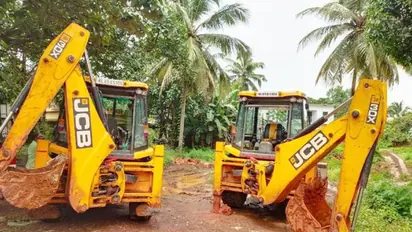Safety matters! Things to keep in mind while using hydraulic vehicles and joysticks

Synopsis
A tragic incident in Pala, Kottayam, resulted in the death of Paul Joseph, 60, when he tried to operate a JCB intended for leveling his yard while the driver was on lunch. Joystick-controlled machinery requires precise handling and can be dangerous if not operated with caution and skill.
A house owner in Kerala tragically died while attempting to operate a JCB brought in for leveling his new house's yard. The incident occurred in Pala, Kottayam. Paul Joseph (60) lost his life when the JCB overturned and crushed him against a rubber tree. He attempted to operate the vehicle while the driver was away for lunch.
This tragic event serves as a stark reminder of the dangers of operating hydraulic vehicles without proper training. Even small excavators require caution due to their powerful hydraulic systems. Untrained individuals attempting to manipulate the joystick risk serious injury or death.
Joystick-controlled hydraulic vehicles require precise control and smooth operation. Only through proper training can one safely control such vehicles. Joysticks control various components like booms, buckets, arms, and steering. While offering precise and smooth operation, they demand careful handling.
Here are some things to keep in mind when using joysticks in hydraulic vehicles:
Know the Joystick Controls
Different machines have different joystick configurations. Understand the specific function of each joystick.
Often, moving the joystick forward or backward extends or retracts the boom, while sideways movements control the bucket or arm positioning. Some excavators use joysticks for travel direction and speed, while others have separate pedals or levers.
Speed and Precision
Joystick controls are typically velocity-sensitive. Gently pressing the joystick moves the machine slowly, while pushing it fully forward increases the speed.
Smooth Movements
Practice smooth, gradual movements. Sudden or jerky movements can lead to loss of control and potential accidents.
Avoid Over-Pushing
Over-pushing or pulling the joysticks can cause the machine to move too quickly or erratically.
Understand Sensitivity
Joysticks are often very sensitive, and even small movements can significantly impact the machine's operation. This sensitivity allows for precision but requires careful handling.
Practice Precision
If you are unfamiliar with such equipment, practice in a safe, obstacle-free environment. Focus on making small, controlled movements to understand how much pressure is needed to achieve the desired movement.
Coordinate Movements Carefully
Some hydraulic machines may require using the joystick to control multiple movements simultaneously, such as extending the boom while rotating the bucket. Practice coordinating these movements to avoid overloading the system or causing unintended actions.
Avoid Sudden Shifts
Switching from one movement to another too quickly or abruptly changing directions can stress the hydraulic system.
Observe Machine Response
Pay attention to how the hydraulic system responds to your joystick inputs. If the machine moves slowly or erratically, it could be due to low hydraulic fluid, system pressure, or mechanical issues. If the machine is not responding as expected (e.g., it is shaking or stalling), stop and investigate the problems.
Use Both Hands
For greater control, use both hands when operating the joystick. One hand controls the movement of the excavator's arm, while the other controls the bucket or the machine's travel. This gives you more control and allows for more complex operations.
Know the Limits
Joysticks often control an arm or bucket through a defined range of motion. Exceeding these limits can cause the machine to operate outside its optimal range, leading to damage or system failure.
Be Aware of Obstacles
Always be aware of the machine's surroundings when moving the joystick, especially when extending the boom or lowering the bucket. This helps avoid obstacles on the site, damaging the equipment, or injuring others.
Get all the latest Automobile News, including updates on Electric Vehicles, new car and bike launches, reviews, and auto industry trends. Stay informed about mileage comparisons, performance insights, and expert opinions to guide your next vehicle choice. Download the Asianet News Official App for all the latest updates from the world of automobiles.